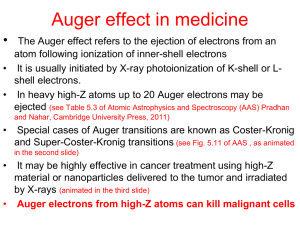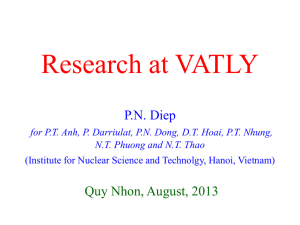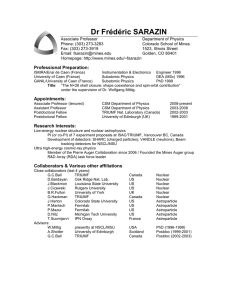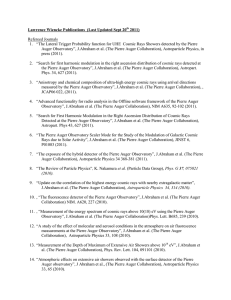On the possibility to discriminate the mass of the primary cosmic ray
advertisement
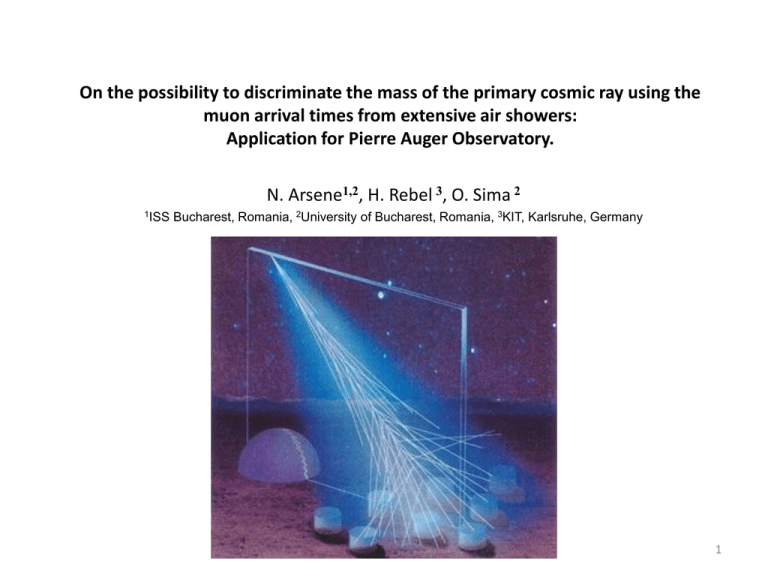
On the possibility to discriminate the mass of the primary cosmic ray using the muon arrival times from extensive air showers: Application for Pierre Auger Observatory. N. Arsene1,2, H. Rebel 3, O. Sima 2 1ISS Bucharest, Romania, 2University of Bucharest, Romania, 3KIT, Karlsruhe, Germany 1 Content : 1. Cosmic rays energy spectrum 2. Extensive air showers (EAS) 3. EAS experimental techniques at the Pierre Auger Observatory (PAO) 4. Methods to determine mass of primary cosmic ray 5. On the possibility to discriminate the mass of the primary cosmic ray using the muon arrival times 6. Results and outlook 2 1. Cosmic rays energy spectrum T heenergyspectrumof primarycosmicrays extendsfrom1 GeV to above1020 eV J(E) E γ J(E) 1 particle/ m2s to 1 particle/ km2century " knee" 1015 1016 eV " ankle" 6 x 1019 eV Greisen–Zatsepin– Kuzmin cutoff (GZK cutoff) 5 x 1019 eV 3 2. Extensive air showers (EAS) 4 2. Extensive air showers (EAS) (Xmax X0 ) ~ E0 and primarymass (X Xmax ) ~ lnE0 nucleus primary(A nucleons) X max ~ E 0 /A X max ~ lnA ( Xmaxp - XmaxFe ) ≈ 100 g cm-2 Gaisser–Hillas : λ 70 g/cm2 Nishimura–Kamata–Greisen (NKG) approximation : Nch = the total number of charged particles s = “age” parameter r0 = Moliere radius ~ 79 m C = constant 5 2. Extensive air showers (EAS) Heck D. et al.[3] Longitudinal EAS development. MC simulations with CORSIKA 6 3. EAS experimental techniques at the Pierre Auger Observatory (PAO) Southern Hemisphere, Argentina Primaryenergy 1018 eV exceeding1021 eV Surface 3000 km2 1600 surface detectors water Cherenkov (SD) 4 stations fluorescence detectors A. Creusot [4] 7 3. EAS experimental techniques at the Pierre Auger Observatory (PAO) Water Cherenkov tanks AUGER COLABORATION [5] altitude 1500 m diameter 3.6 m height 1.55 m detects : muons, electrons, positrons, photons 8 3. EAS experimental techniques at the Pierre Auger Observatory (PAO) Surface detectors reconstruction AUGER COLABORATION [5] , Eveniment recorded by Pierre Auger Observatory , E = 5 x 1018 eV Primary energy : E(EeV) 0.12 [ 1 11.8(sec( ) - 1) 2 S(1000)] 1.05 9 3. EAS experimental techniques at the Pierre Auger Observatory (PAO) Fluorescence detectors (FD) Jos Bellido, for the ́ Pierre Auger Collaboration [6] 3.5 m x 3.5 m spherical mirror -> 440 PMT camera Field of view 300 azimuth x 28.60 elevation 1 pixel -> 1.50 10 3. EAS experimental techniques at the Pierre Auger Observatory (PAO) Fluorescence detectors (FD) reconstraction Shower Detector Plane reconstruction : χ 2 w i (nSDP ri ) 2 minimum i wi signal in pixel" i" ri direct ionin t hesky n SDP vector SDP nSDP errors ̴ tenths of a degree Shower Axis reconstruction : AUGER COLABORATION [5] t i,exp t 0 R p /c tan[(0 - i )/2] Shower axis errors ̴ 1 degree 11 3. EAS experimental techniques at the Pierre Auger Observatory (PAO) Fluorescence detectors (FD) reconstraction AUGER COLABORATION [5] Eveniment recorded by PAO, zenith angle = 56º , distance core - FD detector = 13 km 12 4. Methods to determine mass of primary cosmic ray Dependence of Xmax : M. Risse [8] Longitudinal showers profile . MC simulations, E=10^19 eV, vertical 13 4. Methods to determine mass of primary cosmic ray Correlation between Xmax and Nµ (Patrick Younk and Markus Risse, 2009) : Patrick Younka, Markus Rissea [9] Xmax - Nµ distribution , E = 1019 eV, zenith = 45 ͦ. Average per 1000 simulations using Conex code with QGSJET-01 model a) b) Ideal detectors Real detectors : σ Nµ = 20 % σ Xmax = 20 g cm-2 14 4. Methods to determine mass of primary cosmic ray Time asymmetry in the shower development Hernan Wahlberg, for the Pierre Auger Collaboration [10] Position of maximum asymmetry vs. primary energy for different models and primaries. Hernan Wahlberg, for the Pierre Auger Collaboration [10] Asymmetry development for the different samples t ½ = mean risetime r = radius ζ = azimuth angle Θ = zenith angle 15 5. On the possibility to discriminate the mass of the primary cosmic ray using the muon arrival times Proposed by H. Rebel et al. for KASCADE colaboration, 2003 [12] 16 6. Results and outlook Azimuthal distributions of muons in observable plane.p, E=8x10^17eV, zenith=30,S->N, CORSIKA - QGSJET01 model 17 6. Results and outlook Momentum distribution of muons at ground , CORSIKA simulations – QGSJET01 model 18 6. Results and outlook Distribution of arrival times of muons at ground , CORSIKA simulations – QGSJET01 model 19 6. Results and outlook Distribution of the reconstructed atmospheric depth of muon production , CORSIKA simulations – QGSJET model 20 6. Results and outlook Distribution of the reconstructed atmospheric depth of muon production using infill array detectors, average over 10 simulations (left) and 100 simulations (right) 30 +/- 3 muons in infill detectors Fe, E=8x10^17 eV 20 +/- 2 muons in infill detectors p, E=8x10^17 eV Xmax mu p ≈ 400 g cm-2 Xmax mu Fe ≈ 250 g cm-2 21 6. Outlook Average number of muons per square meter as a function of radial distance to the core of the shower. Averaged over 100 showers with one sigma as error bars. Zero inclination. [11] - Analisys of a large set of CORSIKA simulations with primary energy above 10^18 eV - Find maximum distribution of the reconstructed atmospheric depth of muons production - Possibility to implement this method as a complementary method for determine the primary cosmic ray mass in Pierre Auger Experiment 22 Bibliography : [1] Engel R. et. Al. 2011, Annu Rev. Nucl. Part. Sci. 61:467-89 [2] Diego Garca Gamez, 2010, Dpto. de Fsica Teorica y del Cosmos & CAFPE Universidad de Granada [3] Heck D et al 1998 FZKA Report Forschungszentrum Karlsruhe 6019 [4] A. Creusot, 2010, Latest results of the Pierre Auger Observatory, Nuclear Instruments and Methods in Physics Research A 662 (2012) S106–S112 [5] AUGER COLABORATION, Properties and performance of the prototype instrument for the Pierre Auger Observatory, Nuclear Instruments and Methods in Physics Research A 523 (2004) 50–95 [6] Jos Bellido, for the ́ Pierre Auger Collaboration, Mass Composition Studies of the Highest Energy Cosmic Rays, arXiv:0901.3389v1 [astro-ph.HE]. [7] M. Unger, et al [Pierre Auger Collaboration], Proc. 30th ICRC, , Merida, (2007), arXiv:0706.1495v1 [astro-ph]. [8] M. Risse, Acta Phys.Polon. B35 ,1787, (2004), arXiv:astro-ph/0402300v1. [9] Patrick Younka, Markus Rissea, Sensitivity of the correlation between the depth of shower maximum and the muon shower size to the cosmic ray composition, 10.1016/j.astropartphys.2012.03.001. [10] Hernan Wahlberg, for the Pierre Auger Collaboration, Mass composition studies using the surface detector of the Pierre Auger Observatory , Nuclear Physics B (Proc. Suppl.) 196 (2009) 195–198 . [11] Jochem D. Haverhoek, 2006 , Ultra High Energy Cosmic Ray Extensive Air Shower simulations using CORSIKA [12] I.M.Brancus ,H.Rebel, A.F.Badea et. al. J.Phys.G29:453-474,2003 Features of Muon Arrival Time Distributions of High Energy EAS at Large Distances From the Shower Axis 23 M. Unger, et al [7] Auger results for the Mean Xmax measurements as a function of energy 24
